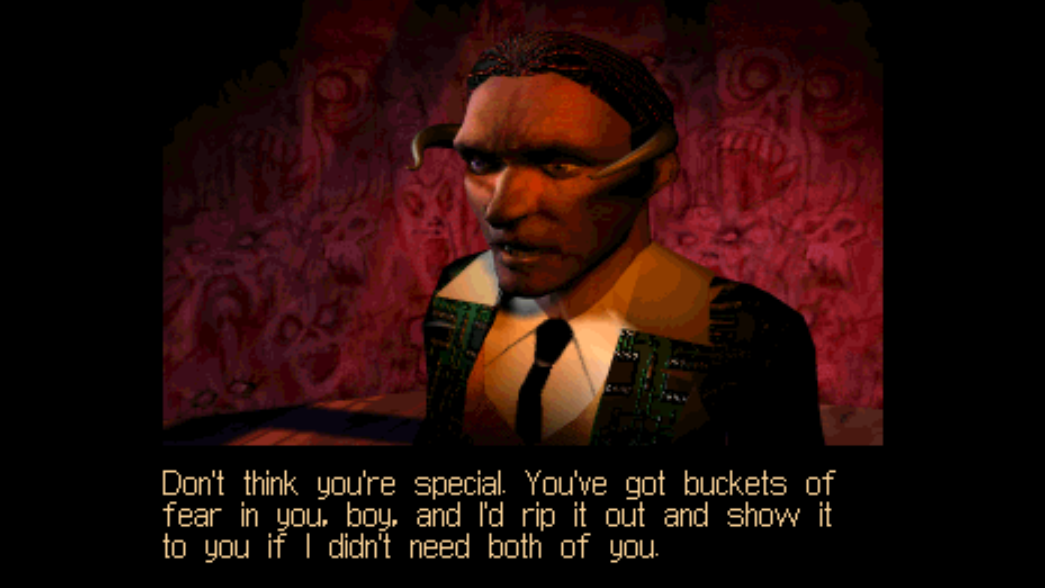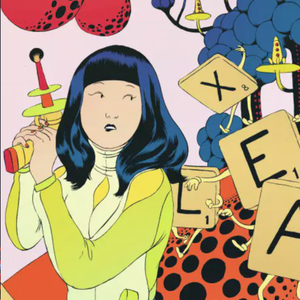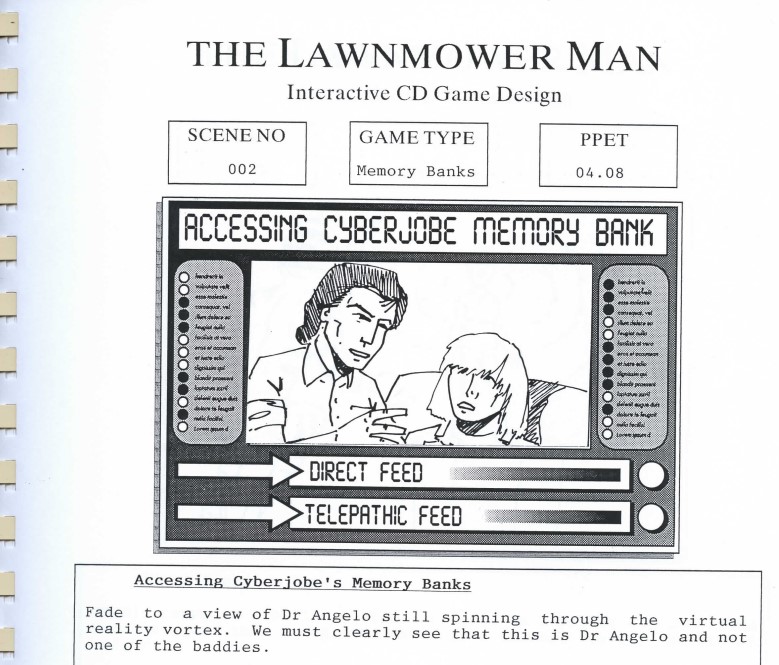The Hollywood-obsessed FMV games of the '90s were weird as hell
Gaming's early attempts to to taken seriously by Hollywood produced some delightfully awkward gems.

In a dim red-tinged room at the back of a sketchy bar, you're trying to get a pesky demonic familiar, Abonides, to let you speak to his hellbound boss. After landing on the right code word, you're suddenly nose-to-nose with a familiar face, with an even more familiar voice—it belongs to a vaguely ominous horned figure in a green blazer made of what appear to be computer chips. "Abonides, you cowering lickspittle," he booms. "I told you to go light on the smoke and brimstone and shit when I'm in my human form. This stuff goes right to my freakin' throat, man."
Who else could it be but the late, great Dennis Hopper?
FMV spawned a beautifully weird subgenre of adventure games that desperately wanted to be just as prestigious as the movies.
Hopper was known for his roles in films like Blue Velvet, Easy Rider, and, of course, the unforgettable live-action Super Mario Bros. He was a true Hollywood icon with a hypnotic screen presence, even when he was playing King Koopa. In 1995 he dipped his toe into the fleeting new weirdness of full-motion videogames, starting with the role of a demon named Mr. Beautiful in Hell: A Cyberpunk Thriller.
Hell, a gloriously dark adventure that combined a fascist dystopia with arcane demonology, was one of the more successful games of its time—a chaotic hybrid of 2D graphics and FMV scenes that you'd probably never see in mainstream game development today. "You've got rocks as big as church bells," Mr. Beautiful sneers at Hell's dual protagonists. "I'm gonna make them ring if you don't watch your step." After giving you a task, you're told, in no uncertain terms, to piss off.
Hell wasn't your ordinary game, but then again, this wasn't an ordinary time. For a few short years in the '90s, full-motion video spawned a beautifully weird subgenre of adventure games that desperately wanted to be just as prestigious as the movies.
The days of FMV were particularly experimental times in game development, as the CD-ROM tried to go Hollywood. While the best-known example of FMV might be Night Trap—a 1992 B-movie-style romp starring Dana Plato from Diff'rent Strokes—it's far from a definitive work. Celebrities like Isabella Rossellini and Teri Garr cautiously tested out the new medium—Rossellini was in a Goosebumps game with Jeff Goldblum and Garr was in the fascinating murder/occult adventure Black Dahlia, with their A-list names sometimes overshadowing most everything else about the games themselves.
"FMV was the next big thing," says Mark Eyles, who worked on the game adaptation of The Lawnmower Man in the early '90s. "There was a revolution in gaming when CD ROMs first became available. The amount of storage was phenomenal compared to the storage available on floppy disks or game cartridges (or even cassette tapes). Being able to have photoreal CGI characters and real people along with real and photoreal CGI locations appearing in games was a novelty."
Keep up to date with the most important stories and the best deals, as picked by the PC Gamer team.
FMV games today are decidedly more polished—Wales Interactive, for instance, has been pumping them out for several years now, and the medium's relationship with Hollywood has endured. Earlier this year, Wales put out The Complex with Katie Dickie (Game of Thrones) and Michelle Mylett (Letterkenny). And of course, there's Sam Barlow's acclaimed Her Story and Telling Lies—two games that briefly pulled FMV back into the spotlight. Telling Lies, especially, feels like a realization of that '90s FMV dream thanks to a cast of established TV and film actors.
But there's something to be said for the sort of disjointed, over-indulgent games that came out of the '90s—a distinct historical flavor that can't be reproduced today, as the games industry has evolved out of its awkward infancy. FMV isn't for everyone, and '90s FMV can be downright alienating to a contemporary audience accustomed to more cohesion and gloss.
Here's a look back at a decade when Hollywood and game development learned to get weird together.
Black Dahlia (1998)
One of the most memorable FMVs of the decade was Take Two's Black Dahlia, a fictionalized adventure inspired by the unsolved historical Black Dahlia killing and Cleveland Torso Murders.
Steve Glasstetter, creative producer and design lead on the game, recalls the slapdash wild west days of games design that took the Black Dahlia crew to the south side of Pittsburgh (he also ended up with a couple of voiceover roles in Hell: A Cyberpunk Thriller).
"We were on a super tight schedule, so every shot had to be meticulously planned and storyboarded well ahead of time," he says. "Even before we booked the studio, we knew exactly how each scene would be shot, where the furniture would be blocked in afterward, and how the rendered environment would impact the final product. If we did more than two takes per shot, we were behind schedule."
Teri Garr, who played Madame Cassandra, rolled up with a foot injury and couldn't stand. "We really had to scramble to reimagine and reblock her scene on the spot, so that we could shoot her sitting down. Fortunately, we'd padded the schedule that day since we were shooting a 'big star,'" Glasstetter recalls. She was very gracious by the way, and apologized profusely for the inconvenience. As I recall, she was also very impressed with [main character actor] Darren Eliker. Darren was always super prepared and had all his lines down by heart each day. I think she might have been a little embarrassed that she needed to refer to the script before each take."
The Lawnmower Man (1993)
While not a full FMV game—the live video mostly appears in backgrounds and cut-outs—Sales Curve's 1993 Lawnmower Man adaptation is a shining example of the liminal space between the burgeoning games world and Hollywood at the time. As one of the earliest adopters of the medium, it's also bewildering to the 21st century eye.
Picking up from the Brett Leonard film, it follows the story of Jobe, an intellectually disabled handyman who becomes a pure virtual being—Cyberjobe—through experiments and drugs. It's a combination of blocky RBG-saturated graphics with thumping techno-lite music and a heavy dose of early 3D surrealism. With little by way of a UI or discernible hints, gameplay was a sort of stream-of-consciousness experience centered around a series of minigames (one of my favorite bits is watching Cyberjobe's floppy noodle limbs during a running/obstacle course sequence).
Eyles also treated me to a digital sample of the (massive) Lawnmower Man game design document before holding the complete tome up to the camera on a Zoom call. "I got a local artist, Neville Stannik to produce artwork (ink drawings) for the document," he says, gesturing at the cover. "I wrote the words on (I think) an Atari ST I was using for word processing, printed them out and then pasted up the artwork and text on paper before taking it round to a local office supplies shop with a photocopier where I could produce the finished pages."
Goosebumps: Escape from Horrorland (1996)
Dreamworks Interactive absolutely nailed one of the most perfect uses of FMV: Bringing an R.L. Stine story to life in full 90s-drenched glory. It's not complicated—after getting dumped in the Horrorland theme park, a group of kids have to get back to reality.
The real treasure in this game is the creative direction. The combo of backgrounds and 3D art add an early Tim Burton flavor to the gameplay (one brief puzzle sequence uses pseudo-claymation valves and pipes as a nice touch), from the seamless scene transitions to the delightfully rich production details—down to the animated cockroach that occasionally escapes from your carpetbag inventory. Even the briefest animated sequences of a mummified hand are immensely, juicily satisfying. Whoever did foley for this game probably had a blast.
The real stars of the show here are the kids, but I can't leave out the fact that the game also had Jeff Goldblum as Dracula and Isabella Rossellini as Lady Cadaver—Rossellini appears in an incredibly ornate costume and chases you around the room before getting smacked down by the equivalent of a gothic murphy bed. As Lizzy, you have to do a macabre dance with Goldblum while secretly fishing for an item in his robe.
Maybe not the most replayable game for adults, it's got a specific flavor of cheese (and some marvelous character acting) that remains impossible to reproduce.
The X-Files Game (1998)
1998 gave us The X-Files adventure game (not to be confused with the 2004 survival game Resist and Serve), an enormously expensive endeavour at the time complete with appearances by Mulder, Scully, Skinner, and everyone's favorite hackers The Lone Gunmen (bonus: you can also unlock Mulder's nemesis, The Smoking Man, if you play your cards right). Based on a story by Chris Carter and Frank Spotnitz, events unfolded into pretty standard weirdo fare with an alien body-possession theme. But for X-Files fans, including yours truly who was part of a Geocities X-Files web-ring at the time, engaging with the X-Files universe in a different medium was the greatest thing since sliced bread.
Mercifully, gameplay went beyond simple clicking a la the Star Trek interactive movies—you had a full-fledged point-and-click system, an inventory, and actual scenarios to deduce. Sadly, the actor who played Agent Craig Willmore, Jordan Lee Williams, passed away in 2018.
Star Trek: Klingon (1996) and Star Trek: Borg (1996)
Gowron remains a fan favorite for a huge swathe of The Next Generation community, and this is the game that his actor, Robert O'Reilly, deserved. It's a fantastic journey through one young Klingon's rite of passage through adolescence—the Rite of Ascension. With Jonathan Frakes directing, O'Reilly absolutely crushes every player-facing interaction and chews scenery like he was born for the part. It would have been interesting to witness the ascension of a non-warrior Klingon in such an honor-driven society—perhaps a kid like Worf's son Alexander—but playing as protagonist Pok is an exhilarating jaunt into the heart of ordinary Klingon relationships.
There aren't any puzzles or real interactive elements beyond pushing the plot along by clicking, but Pok's first-person perspective makes this an invaluable part of Star Trek worldbuilding in ways the show couldn't deliver. Give me a Klingon family sitcom game or give me death.
There's a whole other game—Star Trek: Borg—where you get to bask in the full unmitigated screen presence of John DeLancey's iconic character Q, which is also a great companion to the television series.
Flash Traffic: City of Angels (1994)
The makers of Flash Traffic probably didn't anticipate that it would age well, but revisiting it is still a somewhat entertaining romp through some of FMV's most "we did it because we could" vehicles. Race against time to find a nuclear bomb in LA with a cop buddy played by Ash Adams (credited as Jason Adams) who starred in Ryan's Hope and the 90s cable hit Acapulco Bay. Game writer Chuck Pfarrer, a former SEAL team commander, also wrote the screenplays for films Hard Target (1993), The Jackal (1997), and Red Planet (2000).
Beepers and Brylcreem—what more could you ask for?
Ripper (1996)
Part of me wonders whether Christopher Walken, Paul Giamatti, Karen Allen, Tahnee Welch, and John Rhys-Davies ever look back on their time making Ripper and think about making more FMV games (personally, I'd consider this a huge win). Take Two really went all-out with the Blue Oyster Cult-laden intro sequence (including some amazing uses of slow-mo), and it's one of the most memorable examples of the medium.
It's a great Jack the Ripper-style murder mystery set in the future, where cyberspace exists side-by-side with anachronistic fedora hats (not entirely unlike the sort of old world-meets-dystopian future combination seen in the Tex Murphy games). The game environments are wonderful examples of FMV, with the level of detail, creative direction and production value you'd expect from a game starring such massive celebrities. The transition sequences are especially delightful—the tie-dyed swirls of color that brought you into a bizarre virtual, surrealist realm were pure, indulgent aesthetic candy.

Alexis Ong is a freelance culture journalist based in Singapore, mostly focused on games, science fiction, weird tech, and internet culture. For PC Gamer Alexis has flexed her skills in internet archeology by profiling the original streamer and taking us back to 1997's groundbreaking all-women Quake tournament. When she can get away with it she spends her days writing about FMV games and point-and-click adventures, somehow ranking every single Sierra adventure and living to tell the tale.
In past lives Alexis has been a music journalist, a West Hollywood gym owner, and a professional TV watcher. You can find her work on other sites including The Verge, The Washington Post, Eurogamer and Tor.


